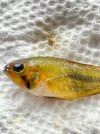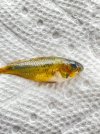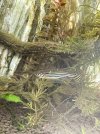Hi. I'm hoping someone can help me figure out what killed my fish. I purchased a male/female pair of apisto cacas about 6 weeks ago and they seemed to be doing fine. But just recently the female started acting differently, not out and about, but hiding either in the pot I placed there for breeding or under plants. I was hoping she was about to lay eggs, but last night she didn't come out to eat, and this afternoon I found her dead. I took some pics. Her eyes seem larger diameter and black, and there appears to be blood under her gills and around her eyes. All the other fish seem fine. Water chemistry seems fine:
- Temp 78.2
- Ph 6.8
- Ammonia .25ppm
- Nitrite 0ppm
- Nitrate 5.0ppm



